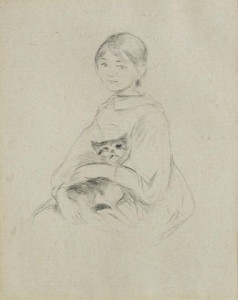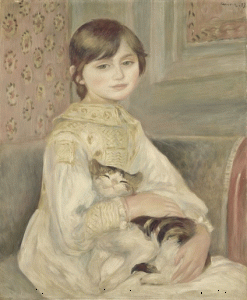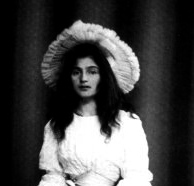 Otto Klemperer is interviewed by John Freeman on Face to Face, originally telecast on the BBC in 1961:
Otto Klemperer is interviewed by John Freeman on Face to Face, originally telecast on the BBC in 1961:
(This is the latest in a series of arts-related videos that appear in this space each Monday, Wednesday, and Friday.)
Terry Teachout on the arts in New York City
 “The actor’s technique is that personal and very private means by which you get the best out of yourself. Every actor does it differently. There’s never been an artist alive who didn’t have to deal with form and content. Those who deal only with content are the ones who act with their guts, but who’s interested in their guts? We’re interested in Hamlet’s guts, or Richard III’s guts, and you have to be heard in the back row. Of course you must have content, but you’ve got to have form. The thing is to marry the two so the form isn’t noticed. Form without content, forget it.”
“The actor’s technique is that personal and very private means by which you get the best out of yourself. Every actor does it differently. There’s never been an artist alive who didn’t have to deal with form and content. Those who deal only with content are the ones who act with their guts, but who’s interested in their guts? We’re interested in Hamlet’s guts, or Richard III’s guts, and you have to be heard in the back row. Of course you must have content, but you’ve got to have form. The thing is to marry the two so the form isn’t noticed. Form without content, forget it.”
Hume Cronyn (quoted in the New York Times, June 17, 2003)
 Mrs. T and I have just added a new piece to the Teachout Museum, a posthumous impression of an unsigned drypoint by Berthe Morisot, a member of the original circle of French Impressionists. It was made in 1888 or 1889 and is variously known as “Jeune fille au chat,” “Fillette au chat (Julie Manet),” and “Young Girl with a Cat, after a portrait of Julie Manet by Renoir.” It is, as the third of these titles indicates, based on an 1887 painting by Renoir called “Julie Manet” that is owned by the Musée d’Orsay. The long version of the title is the one used by the Metropolitan Museum of Art, which acquired its copy in 1922.
Mrs. T and I have just added a new piece to the Teachout Museum, a posthumous impression of an unsigned drypoint by Berthe Morisot, a member of the original circle of French Impressionists. It was made in 1888 or 1889 and is variously known as “Jeune fille au chat,” “Fillette au chat (Julie Manet),” and “Young Girl with a Cat, after a portrait of Julie Manet by Renoir.” It is, as the third of these titles indicates, based on an 1887 painting by Renoir called “Julie Manet” that is owned by the Musée d’Orsay. The long version of the title is the one used by the Metropolitan Museum of Art, which acquired its copy in 1922.
We saw Morisot’s print for the first time on a recent visit to Pittsburgh’s Carnegie Museum of Art, where it is proudly hung. Here’s what the Carnegie Museum has to say about “Jeune fille au chat” in its online catalogue:
Known primarily for her paintings of domestic life, Berthe Morisot began experimenting with printmaking in the late 1880s at the encouragement of her Impressionist colleagues. In this drypoint, Morisot lightly sketches her daughter, Julie Manet, a frequent subject of her works. She was Morisot’s only child and the niece of Édouard Manet. Beginning around 1888, Morisot made 12 known etching and drypoint plates, which were deposited with renowned publisher Ambroise Vollard after her death in 1895. Vollard had small editions of her plates printed. The two dots, at the upper center and the lower center, indicate that the print belongs to the posthumous edition produced by Vollard.
 Renoir’s original is lovely and characteristic, but Morisot has in my opinion improved on it by turning his painting into a drypoint, in the process making it at once crisper and (dare I say it?) less obviously sentimental. Julie Manet recalled that Renoir painted the portrait “in small sections, which was not his usual way of working. I thought it was a good resemblance, but when Degas saw it he complained: ‘By doing round faces, Renoir produces flower pots.’”
Renoir’s original is lovely and characteristic, but Morisot has in my opinion improved on it by turning his painting into a drypoint, in the process making it at once crisper and (dare I say it?) less obviously sentimental. Julie Manet recalled that Renoir painted the portrait “in small sections, which was not his usual way of working. I thought it was a good resemblance, but when Degas saw it he complained: ‘By doing round faces, Renoir produces flower pots.’”
I might add that Renoir’s Julie, as was his wont, is an idealized vision of a pretty young girl, whereas Morisot’s Julie is a real person, so real that she all but leaps out of the frame. No doubt this has something to do with the fact that Morisot was Julie’s mother: she knew her better.
 Here’s what I wrote about the print in this space two months ago, a few days after seeing it in Pittsburgh:
Here’s what I wrote about the print in this space two months ago, a few days after seeing it in Pittsburgh:
Morisot tends to get short shrift in discussions of the French impressionists, no doubt in part because she was a woman but also because of the soft-spoken intimacy of her work. The CMA also owns a spectacular Monet water-lily panel in front of which Mrs. T and I lingered, but we came back to “Young Girl with a Cat” twice, and I felt even more strongly on a second viewing that I could look at it every day. Aside from its sheer elegance of execution, I delighted in the sharp features of the young girl portrayed therein. If there is such a thing as a quintessentially French face, Julie Manet had one, and Morisot, her mother, managed to catch it on the etching plate.
When a beautifully framed copy came up for auction in Connecticut this past weekend, I decided to bid on it, and knocked it down for—believe it or not—one hundred dollars. Never let it be said that it isn’t possible to buy classy art on the cheap!
The trouble with my life is not that it’s dull but that it sometimes becomes too interesting, at which point successive waves of beauty can start looking suspiciously like one damn thing after another. Experience has taught me the dangers of overscheduling myself, but though I’ve learned the lesson fairly well, it doesn’t always stop me from signing up for one event too many. Nor do I ever have total control over my schedule: press previews and deadlines fall where they will, not where I would, and every once in a while they become fused with the other parts of my life in such a way as to rob me of the ability to fall asleep. “Oh, God, I’m wired,” I find myself muttering grimly at three in the morning, knowing I’ll have to go on booming and zooming for several days past the last deadline before the adrenalin finally leaches out of my pores and I become my even-keeled self once more….
Read the whole thing here.
An ArtsJournal Blog